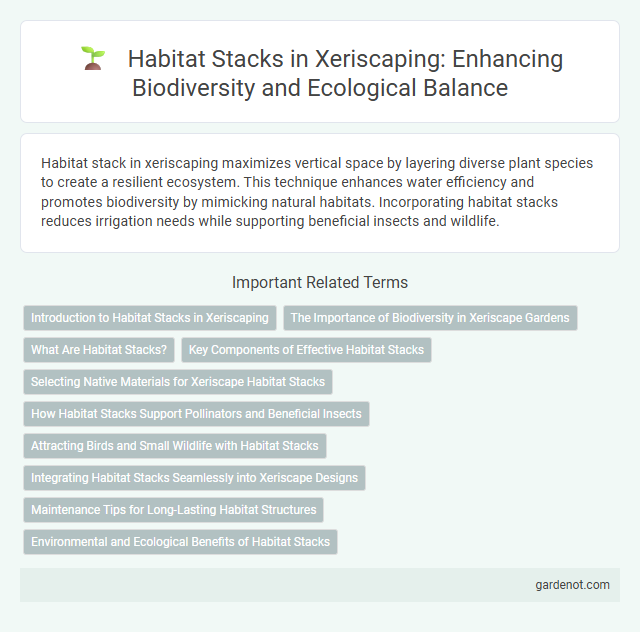Habitat stack in xeriscaping maximizes vertical space by layering diverse plant species to create a resilient ecosystem. This technique enhances water efficiency and promotes biodiversity by mimicking natural habitats. Incorporating habitat stacks reduces irrigation needs while supporting beneficial insects and wildlife.
Introduction to Habitat Stacks in Xeriscaping
Habitat stacks in xeriscaping create layered microenvironments that support diverse native plant and wildlife species while conserving water. These vertical layers maximize space efficiency by combining ground covers, shrubs, and trees adapted to arid conditions, enhancing biodiversity and ecosystem resilience. Integrating habitat stacks reduces irrigation needs and fosters sustainable, low-maintenance landscapes in drought-prone regions.
The Importance of Biodiversity in Xeriscape Gardens
Habitat stacks in xeriscape gardens play a crucial role in enhancing biodiversity by creating layered environments that support various plant and animal species. Incorporating native drought-tolerant plants in these layers attracts pollinators, birds, and beneficial insects, which contribute to a balanced ecosystem. This biodiversity not only improves garden resilience against pests and diseases but also promotes water conservation and soil health.
What Are Habitat Stacks?
Habitat stacks are modular, layered planters designed to support diverse plant species by mimicking natural ecosystems, creating microhabitats that enhance biodiversity in xeriscape gardens. These structures optimize water efficiency and soil retention, making them ideal for drought-resistant landscaping by promoting healthy root systems and reducing irrigation needs. Integrating habitat stacks into xeriscape designs fosters sustainable plant growth and provides shelter for beneficial insects and wildlife, improving overall garden resilience.
Key Components of Effective Habitat Stacks
Key components of effective habitat stacks include layered vegetation with native plants that provide shelter and food sources for wildlife. Incorporating diverse microhabitats such as logs, rocks, and water features enhances biodiversity by supporting different species' needs. Proper spacing and structural variety maximize ecological benefits and resilience in xeriscape environments.
Selecting Native Materials for Xeriscape Habitat Stacks
Selecting native plants such as purple coneflower (Echinacea purpurea), blue grama grass (Bouteloua gracilis), and desert marigold (Baileya multiradiata) ensures a resilient xeriscape habitat stack that supports local wildlife and conserves water. Utilizing locally sourced mulches like shredded bark and decomposed granite enhances soil moisture retention and mimics natural ecosystems. Incorporating rocks native to the region creates microhabitats for insects and small animals, promoting biodiversity within xeriscape environments.
How Habitat Stacks Support Pollinators and Beneficial Insects
Habitat stacks create layered environments that offer diverse food sources, shelter, and breeding grounds essential for pollinators and beneficial insects. By incorporating native plants and organic materials, these stacks enhance ecosystem stability and encourage natural pest control. This diversity improves pollination rates, supporting plant reproduction and overall garden health in xeriscaped landscapes.
Attracting Birds and Small Wildlife with Habitat Stacks
Habitat stacks create layered environments that attract birds and small wildlife by combining native plants, water sources, and shelter in xeriscape gardens. These vertical designs provide essential resources such as food, nesting sites, and protection from predators, enhancing biodiversity while conserving water. Integrating habitat stacks in xeriscaping supports sustainable ecosystems by promoting natural wildlife activity in arid landscapes.
Integrating Habitat Stacks Seamlessly into Xeriscape Designs
Integrating Habitat Stacks into xeriscape designs enhances biodiversity by creating vertical shelters for native wildlife within drought-tolerant landscapes. These structures support pollinators, birds, and beneficial insects, promoting ecological balance while conserving water resources. Strategically positioning habitat stacks among drought-resistant plants ensures a harmonious blend that maintains aesthetic appeal and environmental function.
Maintenance Tips for Long-Lasting Habitat Structures
Regular inspection of habitat stacks ensures structural integrity and prevents damage from weather or pests. Use durable, weather-resistant materials such as untreated wood or stone to enhance longevity. Clearing debris and controlling invasive plants around the stack maintains a healthy environment for native wildlife.
Environmental and Ecological Benefits of Habitat Stacks
Habitat stacks enhance biodiversity by providing layered habitats that support diverse species, promoting ecological balance and resilience. These structures improve soil health through increased organic matter and natural pest control by attracting beneficial insects and pollinators. Water conservation is optimized as habitat stacks facilitate efficient moisture retention and reduce runoff, aligning with sustainable xeriscape principles.
Habitat stack Infographic

 gardenot.com
gardenot.com